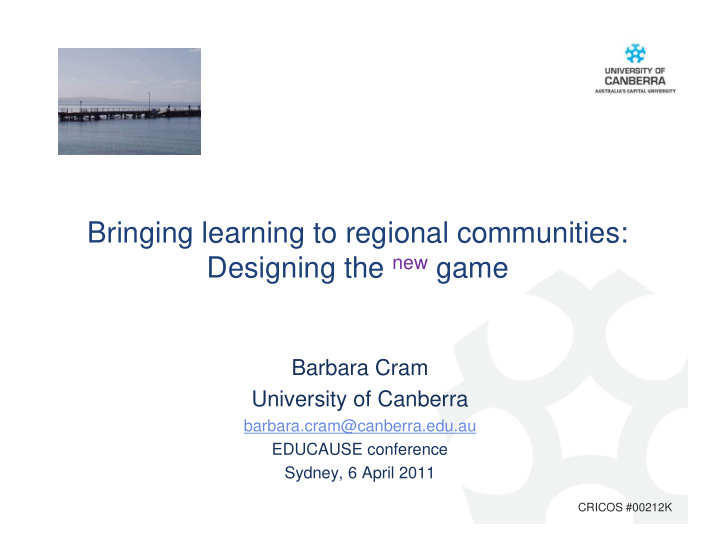



Bringing learning to regional communities: Designing the new game Designing the game Barbara Cram University of Canberra barbara.cram@canberra.edu.au EDUCAUSE conference Sydney, 6 April 2011 CRICOS #00212K CRICOS #00212K
Widening access and increasing participation Drivers for regional engagement in education: “Australia needs a sustainable system of higher education provision in regional and remote areas. Provision needs to be flexible and innovative. It must anticipate and respond rapidly to local needs . Providers in regional and remote areas need to be encouraged and supported to build upon encouraged and supported to build upon partnerships with local communities, providers in other sectors of education, businesses and industry. (Bradley et al. 2008, p.111) B Cram 2011 CRICOS #00212K
Inhibitors to regional access and participation Regional communities report ... 1. Low aspirations and school completion rates 2. Limited educational pathways (school- VET-HE) 3. Social/cultural exclusion 4. Limited access to technology, the internet and academic skills development B Cram 2011 CRICOS #00212K
Internet and broadband access by remoteness % 70 60 50 40 30 20 10 0 Major cities Inner regional Outer regional Remote Very remote Internet access 2001 Internet access 2006 Broadband access 2006 B Cram 2011 CRICOS #00212K
Technology support for learning: Internet connection at home? B Cram 2011 CRICOS #00212K
Technology support for learning: Broadband connection at home? B Cram 2011 CRICOS #00212K
Enablers to regional access and participation Research suggests ... 1. Institutional commitment and strategies to widen access and increase participation (e.g. Lefoe 2003) 2. Regional educational design 3. Specified educational pathways (cross- sectoral) from school-VET-HE sectoral) from school-VET-HE 4. Sharing of infrastructure and resources (educational providers, government bodies and industry) to enhance access to technology and academic support 5. Community leadership and engagement B Cram 2011 CRICOS #00212K
Elements of regional design framework Technology support & design for learning Enhanced Enhanced Teaching, Teaching, student learning & Community access and assessment leadership & practice participation engagement Student support & lecturer PD B Cram 2011 CRICOS #00212K
Design of teaching, learning & assessment strategies Design: Curriculum alignment, skills development; web-enabled; disruptive Design: Situated, problem-based problem-based Interactive, Teaching, learning communicative, & assessment learner-led content Quality assured, cost-effective, sustainable B Cram 2011 CRICOS #00212K
Technology support for learning: Equal access? Computers and video-conferencing: TAFE & schools? Education Centres & libraries? Technological equipment & infrastructure Internet access & broadband: Maccas? Gloria Jeans? B Cram 2011 CRICOS #00212K
Community leadership & engagement Community-led course design and implementation Student support: academic skills, personal support personal support Community Professional leadership and development for staff & engagement community Mobile university Mobile health bus CRICOS #00212K B Cram 2011
Community leadership & engagement Community-led course design and implementation Student support: academic skills, personal support personal support Community leadership and Professional involvement development for staff & community Regional clinical placement bays; b-to-b monitoring & Mobile Allied Health supervision. Transport. (bus) Community sport & rec. Mobile university Mobile university. CRICOS #00212K B Cram 2011
What strategies do you/ would you use to increase participation in regional communities? Group discussion/ brainstorm: 1. Share experiences: How do you/ would you support learning for young and mature aged people living in regional areas? regional areas? 2. Summarise the three most useful technology-based strategies. B Cram 2011 CRICOS #00212K
http://creativecommons.org/licenses/by/4.0/ Conclusion: A new game (based on old rules) 1. Regional communities face intergenerational disadvantage and reduced access to technology and the internet. 2. Enhancing participation in regional education requires innovative, education requires innovative, integrated approaches to educational design, application of technologies and meaningful engagement with community members. B Cram 2011 CRICOS #00212K

Recommend
More recommend